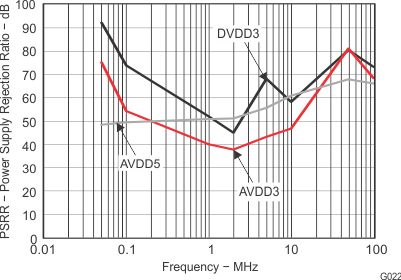SLAS669E September 2010 – may 2020 ADS5400-SP
PRODUCTION DATA.
- 1 Features
- 2 Applications
- 3 Description
- 4 Revision History
- 5 Pin Configuration and Functions
- 6 Specifications
-
7 Detailed Description
- 7.1 Overview
- 7.2 Functional Block Diagram
- 7.3 Feature Description
- 7.4 Device Functional Modes
- 7.5 Programming
- 7.6 Serial Register Map
- 8 Application and Implementation
- 9 Power Supply Recommendations
- 10Layout
- 11Device and Documentation Support
- 12Mechanical, Packaging, and Orderable Information
9 Power Supply Recommendations
The ADS5400-SP uses three power supplies. For the analog portion of the design, a 5-V and 3.3-V supply (AVDD5 and AVDD3) are used, while the digital portion uses a 3.3-V supply (DVDD3). The use of low-noise power supplies with adequate decoupling is recommended. Linear supplies are preferred to switched supplies; switched supplies generate more noise components that can be coupled to the ADS5400-SP. The PSRR value and the plot shown in Figure 41 were obtained without bulk supply decoupling capacitors. When bulk (0.1 μF) decoupling capacitors are used, the board-level PSRR is much higher than the stated value for the ADC. The power consumption of the device does not change substantially over clock rate or input frequency as a result of the architecture and process.
 Figure 41. PSRR versus Supply Injected Frequency
Figure 41. PSRR versus Supply Injected Frequency